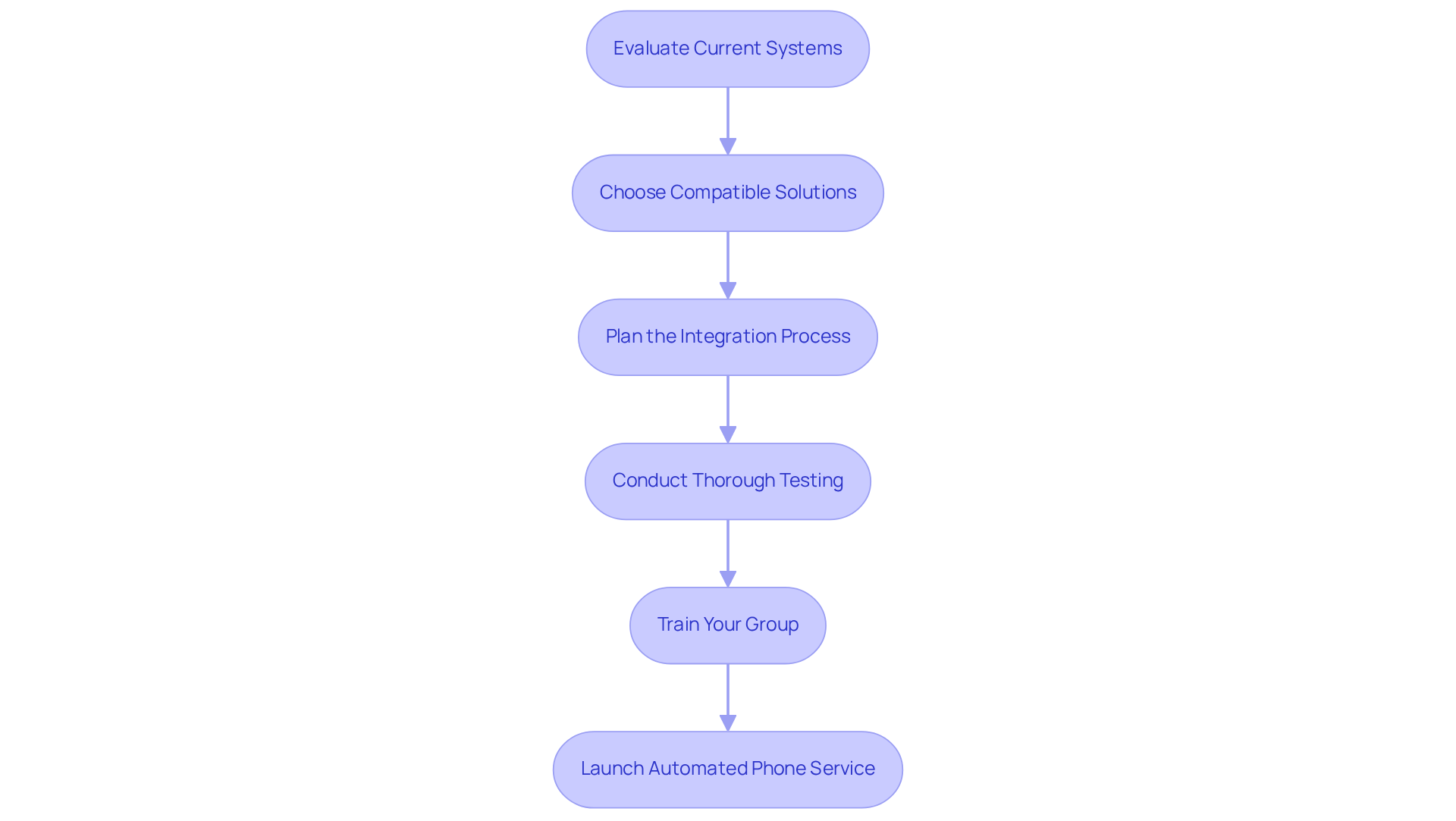Overview
Implementing automated phone services can significantly boost sales performance. By enhancing customer engagement and increasing conversion rates through efficient lead qualification and support, businesses can achieve remarkable results. AI-driven systems improve response times and customer interactions, leading to higher conversion rates—up to 1.5 times greater than traditional methods. Additionally, these systems can result in an average increase of 30% in contact rates.
The data speaks for itself: organizations that adopt these technologies not only streamline their operations but also enhance their overall customer experience. This dual benefit creates a compelling case for action. As companies strive to stay competitive, leveraging automated phone services is no longer just an option; it’s a necessity.
In conclusion, the integration of automated phone services is a strategic move that can transform sales performance. By investing in AI-driven solutions, businesses can expect to see substantial improvements in both engagement and conversion metrics.
Introduction
Automated phone services are transforming the sales landscape, leveraging advanced AI technology to streamline customer interactions and drive revenue growth. These systems not only enhance efficiency but also significantly improve customer engagement and conversion rates. However, organizations face a critical challenge: effectively integrating these automated solutions into existing sales frameworks while setting clear objectives to maximize their potential.
What strategies can businesses adopt to ensure a successful transition to automated phone services that truly elevate sales performance? By addressing this question, companies can unlock the full potential of these innovative tools, paving the way for sustained growth and success.
Understand Automated Phone Services and Their Impact on Sales
Automated phone service leverages cutting-edge AI technology to transform various commercial functions, such as lead qualification, payment reminders, and customer support. By automating these processes, businesses can significantly boost their efficiency and effectiveness in engaging with customers. Intone's AI voice agents are particularly adept at swiftly identifying high-intent leads, enabling teams to concentrate their efforts on prospects with the highest potential for conversion. These human-like interactions not only build trust but also enhance the overall customer experience, facilitating upselling and re-engagement with past buyers.
Moreover, these systems operate continuously, ensuring that customer inquiries are addressed promptly—an essential factor in maintaining high levels of satisfaction and engagement. The impact on revenue performance is substantial; research indicates that organizations utilizing automated phone service can achieve conversion rates up to 1.5 times higher than those relying on traditional methods. In fact, companies employing AI-driven calling solutions have reported an average increase of 30% in contact rates and a 25% reduction in idle time. With real-time monitoring and analytics, managers can refine strategies and scripts to consistently improve performance. This section lays the groundwork for understanding how to effectively harness Intone's AI voice agents to enhance revenue outcomes.

Define Your Objectives for Automated Phone Service Implementation
Establishing clear goals is essential before deploying robotic communication systems aimed at boosting revenue performance. Common objectives might include increasing lead conversion rates, reducing follow-up times, or enhancing customer satisfaction scores. To effectively set these objectives, consider the following steps:
-
Identify Key Performance Indicators (KPIs): Select metrics that will accurately measure the effectiveness of your automated communication. Relevant KPIs could include conversion rates, average call handling times, and customer feedback scores. For instance, companies that effectively leverage KPIs can see a significant productivity boost, with marketing automation contributing to a 14.5% improvement in this area.
-
Align Objectives with Business Goals: Ensure that your objectives align with broader business goals, such as revenue growth or market expansion. For example, if your aim is to increase revenue by 20%, your automated phone service should be strategically designed to support this target.
-
Set Realistic and Achievable Goals: While it's important to aim high, ensure that your objectives are attainable within a reasonable timeframe. This approach helps maintain team motivation and focus, fostering a culture of accountability.
-
Document Your Objectives: Clearly articulate your goals and share them with your team. This transparency ensures that everyone is aligned and understands the purpose of the electronic communication system, which is crucial for effective implementation.
By establishing clear goals, you lay a strong foundation for the successful implementation of robotic communication systems, ultimately enhancing revenue performance.

Integrate Automated Phone Services with Your Current Sales Infrastructure
Integrating your current sales infrastructure with automated phone services is a strategic move that can significantly enhance your operations. Here’s how to do it effectively:
-
Evaluate Current Systems: Begin by assessing your existing tools and processes. Identify how robotic call solutions can enhance them. This includes a thorough review of your CRM systems, lead management tools, and communication platforms. Notably, 91% of firms with 11 or more staff members utilize CRM software, underscoring its critical role in business operations.
-
Choose Compatible Solutions: Select robotic communication options that integrate seamlessly with your current systems. Look for providers that offer APIs or integration capabilities to ensure a smooth connection. Companies that successfully integrate AI with their CRM systems report a 15% increase in repeat transactions and customer retention, highlighting the benefits of compatibility.
-
Plan the Integration Process: Develop a detailed plan outlining how the integration will proceed. This should encompass timelines, responsibilities, and any necessary training for your team. Effective planning is essential; while 75% of organizations expect employees to automate processes, only 8% provide adequate training on how to do so.
-
Before fully launching the automated phone service, conduct thorough testing to identify any potential issues. This step is crucial to ensure the system operates as intended and that data flows seamlessly between platforms. Companies that prioritize testing often see a 20% reduction in human errors with automation.
-
Train Your Group: Offer comprehensive training for your marketing team on how to effectively use the new system. Familiarity with automation tools can significantly boost productivity, as representatives who embrace automation frequently report higher job satisfaction and efficiency.
By thoughtfully integrating automated communication systems with your existing sales framework, you can enhance efficiency and facilitate a smooth transition for your team, ultimately leading to improved sales outcomes.

Monitor Performance and Optimize Your Automated Phone Service
Once your automated communication system is up and running, regular performance monitoring becomes essential for maximizing its effectiveness. Here’s how to track and optimize your service:
-
Establish Performance Metrics: Identify the metrics that align with your revenue goals. Key indicators include call conversion rates, average handling time (AHT), and customer satisfaction scores (CSAT). A good CSAT typically falls between 75% and 85%.
-
Utilize Analytics Tools: Take advantage of the smart analytics tools integrated into Intone's automated telephone system. These tools deliver real-time insights into performance metrics, allowing you to spot trends and areas needing improvement. For example, monitoring the average speed of answer (ASA) is crucial, as 90% of customers indicate that a quick response is vital.
-
Gather Feedback: Regularly seek feedback from both your sales team and customers. This qualitative data can reveal insights that quantitative metrics might miss, helping you grasp user experiences and expectations. Notably, 77% of customers expect to reach someone immediately when contacting a company, underscoring the urgency of responsiveness.
-
Make Data-Driven Adjustments: Use the insights gained from your analytics and feedback to inform modifications to your offering. This could involve refining call scripts, enhancing targeting criteria, or improving integration with other systems to streamline operations. Setting clear, measurable goals using the SMART approach can effectively guide these adjustments.
-
Conduct Regular Reviews: Schedule regular assessments of your automated communication platform’s performance. These evaluations are crucial for measuring effectiveness and ensuring the offering adapts to your evolving business needs, ultimately enhancing revenue results.
By actively monitoring and optimizing your automated phone service—especially with the customization and real-time insights provided by Intone's AI sales agents, which include 24/7 availability and the Agent editor feature for script uploads—you can transform it into a powerful tool for boosting sales performance and enhancing customer engagement.

Conclusion
Implementing automated phone services can be a game-changer for businesses aiming to enhance their sales performance. By leveraging advanced AI technology, organizations can streamline their processes, improve customer interactions, and ultimately drive higher conversion rates. The integration of automated systems not only facilitates efficient communication but also empowers sales teams to focus on high-potential leads, fostering a more productive sales environment.
Key insights underscore the importance of:
- Defining clear objectives for implementation
- Integrating automated services with existing sales infrastructure
- Continuously monitoring performance
Establishing measurable KPIs and utilizing analytics tools are crucial for assessing the effectiveness of these systems. Additionally, gathering feedback and making data-driven adjustments can significantly enhance customer engagement and satisfaction, leading to improved sales outcomes.
In conclusion, adopting automated phone services is not merely a trend but a strategic necessity for businesses looking to thrive in a competitive landscape. Embracing these technologies can unlock new levels of efficiency and effectiveness in sales operations. Organizations are encouraged to take proactive steps towards implementing automated solutions, as doing so can lead to substantial improvements in both revenue and customer experience. The time to act is now—transform your sales processes and reap the benefits of automation.
Frequently Asked Questions
What is automated phone service?
Automated phone service utilizes advanced AI technology to streamline commercial functions such as lead qualification, payment reminders, and customer support.
How does automated phone service benefit businesses?
It boosts efficiency and effectiveness in customer engagement, allowing businesses to focus on high-intent leads and enhance the overall customer experience.
What are Intone's AI voice agents capable of?
Intone's AI voice agents can quickly identify high-intent leads, facilitating upselling and re-engagement with past buyers through human-like interactions.
How does automated phone service affect customer satisfaction?
These systems operate continuously, ensuring prompt responses to customer inquiries, which is crucial for maintaining high satisfaction and engagement levels.
What impact does automated phone service have on revenue performance?
Organizations using automated phone service can achieve conversion rates up to 1.5 times higher than traditional methods, with reported increases of 30% in contact rates and a 25% reduction in idle time.
How can managers improve performance using automated phone services?
Real-time monitoring and analytics allow managers to refine strategies and scripts to consistently enhance performance.






